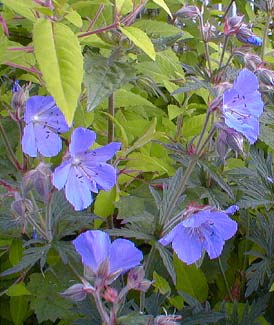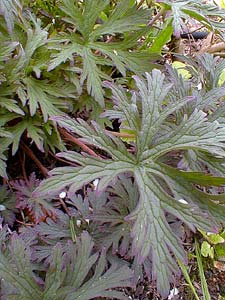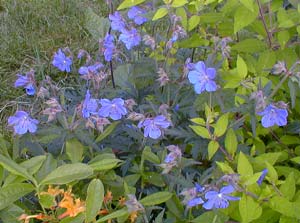 Geranium pratense:
Geranium pratense:
The Lore of Meadow Crane's-bill
illustrated with photos of
'Victor Reiter Jr'
Purple Meadow Crane's-bill
"Geraniums bloom better if they are spoken to."
-Victoria Glendinning,
b. 1937
b. 1937
G. pratense has a long gardening history, & would already have been a very old garden choice in the Elizabethan Era, when it went by such names as Crowfoot Crane's-bill, Bassinets, Loving Andrews, & Gratia Dei (Grace of God).
The name Bassinet Geranium doesn't refer to baby bassinets, but is derived from a French word for "Salver," due to the bowl-shape to the little blue blooms. The name Gratia Dei was a translation into Latin coopted right from its medieval German name, Gottesgnade, which in turn derived from its oldest name of all, Odin's Grace, or Odin's Flower, indicative of its ancient to medieval sacred valuation.
 It was once gathered in Iceland for the manufacture of a blue dye, the secret method being now forgotten. Very likely it was the source of color in priests' robes or was the purple of kings. It was in any case the color that indicated the presence of Odin, & was the color of His mantle & His eyes.
It was once gathered in Iceland for the manufacture of a blue dye, the secret method being now forgotten. Very likely it was the source of color in priests' robes or was the purple of kings. It was in any case the color that indicated the presence of Odin, & was the color of His mantle & His eyes. The sacredness of the color blue is preserved to this day in that it is said to have been the color of the Virgin Mary's veil. More whimsically, in the phrase "Swearing a blue streak," this means "to take a God's name in vain," & especially in French using the word "Bleu" in lieu of "Dieu" (diety) is a common way of cleaning up a swear phrase.
So Odin's flower in its natural wild form is lilac-blue. What is additionally curious is that this color was sacred to Saint Andrew, & the X symbol of Scotland shown white against a blue field adheres to this color scheme in honor of Scotland's patron saint.
Exactly why this crane's-bill was called Loving Andrews is long forgotten, but the color blue is not the only link between Odin & Andrew. I would strongly hazard that this coopted the Germanic & Nordic sacredness to Odin God of Wisdom & transferred the plant to Andrew the Apostle, who was likewise associated with wisdom.
 In Germany, wherein the worship of Wotan died out with the arrival of christianity, it was traditional among young women to pray on Saint Andrews' Feast Day for a vision of their future husbands, who would come to the women in their dreams if they slept naked on that night. By right of his association with the Bride of Cana, Andrew was patron saint of marriages. This association of Andrew with "Love" & with Odin's flower could easily have been brought to Great Britain by Britain's royal line, itself Germanic, which is the very reason Andrew became the patron saint of Scotland.
In Germany, wherein the worship of Wotan died out with the arrival of christianity, it was traditional among young women to pray on Saint Andrews' Feast Day for a vision of their future husbands, who would come to the women in their dreams if they slept naked on that night. By right of his association with the Bride of Cana, Andrew was patron saint of marriages. This association of Andrew with "Love" & with Odin's flower could easily have been brought to Great Britain by Britain's royal line, itself Germanic, which is the very reason Andrew became the patron saint of Scotland.Though I've never seen this explanation corroborated by other authors, I'm convinced these are the reasons Meadow Crane's-bills were formerly called Loving Andrews. The possibility can be strengthened by showing further connections between Odin & Andrew, increasing the probability of the saint displacing the god especially among Germanic & Scottish peoples, to whom both figures had substantive meaning for faith & nationalism, with Scotland's capitol to this day baring the name Edinburgh or Odin's Town.
Fitting Odin's Celtic Cross to Andrew's symbol of the letter "X" (representing his crucifixion) is not such a stretch, though as a symbol of Scotland the X may well be older than its association with Andrew. Most compelling are the marriage rituals surrounding the Odin Stone of Orkney, just one of many indicators that Odin was not merely god of wisdom, war, & poetry, but was before Andrew the patron of marriage & fecundity, for Odin was still honored as such by the semi-christianised Orcanians well into the 1700s.
Geranium pratense 'Victor Reiter Jr.'
Geranium pratense 'Genric' aka 'Summer Skies'
Geranium pratense 'Hocus Pocus'
Geranium pratense x clarkei 'Brookside'